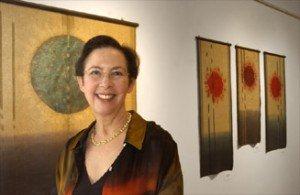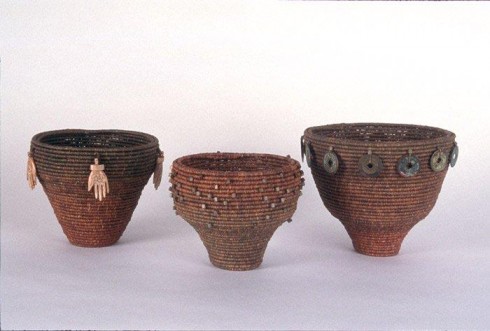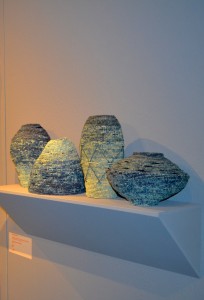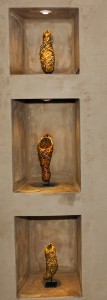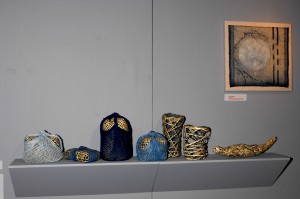For Barbara Shapiro, an accomplished weaver and participant in the San Francisco Art to Wear movement (1970’s-1980’s), who then went on to create woven wall pieces evocative of the historical and ethnic textiles about which she writes and lectures, basketry has been a recent addition to her artistic repertoire.
Nevertheless, her 5 installations of baskets, recently exhibited at the Petaluma Arts Center as part of Four Weavers: Contemporary Expressions of an Ancient Craft, was powerful and unique , integrating her intimate knowledge of indigo dying & traditional art forms with techniques and forms reminiscent of ancient pottery & basketry, and uncommon surface treatments. Her installations clearly demonstrated the powerful effect of grouping a series of similar pieces to illustrate the multiple facets of a common theme.
It was a CNCH conference workshop on embellishment taught by Lissa Hunter some 10 years ago which “changed[Barbara’s] artistic life” and began her “explorations of basketry as a means of textile expression.” Instead of working with purchased Philippine baskets that Barbara had brought to the class, Lissa encouraged her to weave her own. Barbara found coiling with waxed linen compatible with her previous weaving experience, but started by unrolling the linen bobbin, and first painting the thread with acrylics– a treatment which gave the completed baskets a patina of antiquity.
Although she initially used 16 gauge wire as her core coiling material, after learning of the toxicity of that material (for instance, the telephone wire used in Zulu basketry is now thought to have caused cancer in the weavers), Barbara switched to paper rush covered wire.
Ingenuity and continuity with past experience with indigo dying informed Barbara’s collection of pottery-like indigo baskets from dyed and coiled raffia.
To create the variety of indigo tones, Barbara dipped her raffia hanks into her dye baths various times, creating a continuum of color ranging from what appears white (although is really a very light blue!) to dark indigo.
Barbara’s latest coiled work, a wall installation called Testing Testing , incorporates indigo test strips saved from 25 years of maintaining indigo vats at San Francisco State University, which are coiled with black waxed linen.
“I [was] thinking about the passage of time, the creative possibilities of recycled materials, and the universality of indigo.” Barbara’s romance with indigo has a personal and historical meaning as well; she points out that in the Middle Ages it was often Jewish dyers and traders that dealt with the indigo marketed in North Africa, the Middle East and via the Silk Road, and that indigo fabrics held significant cultural ramifications denoting class and wealth.
Barbara’s remaining exhibit installations, two separate groups of plaited cane pieces, also integrated indigo dyeing techniques. The first, which provided multi-colored plaited cane hanging & seated baskets for illuminated niches in the Petaluma Art Center entry hall, represented Barbara’s “desire to make one hundred plaited baskets in an effort to achieve…mastery of this technique” as well as “to explore as many different shapes as I can come up with.” To create these forms, Barbara used tortoise shell cane & dyed indigo cane in hexagonal woven structures which were then over-plaited in random weave. Barbara credits her start in plaiting with cane & bamboo to a “wonderful CNCH workshop taught by Nancy Moore Bess about 8 years ago.”
Wrapping Memory, a conceptual work inspired by Korean Pojagi or wrapping cloths, was Barbara’s response “to the loss of my brother and the need to cherish and hold on to his memory. The indigo dyed cane forms wrapped in tattered indigo gauze as well as other baskets now falling apart all mark the passage of time and our need to remember those we love.” The included boat is a “universal symbol of the journey to the next world.”
Barbara Shapiro is a longstanding member of the Black Sheep Guild, and is a welcome member of the Bay Area Basket Makers (BABM), and continues to teach classes locally & internationally, including her newest workshop, “A Greener Indigo” which demonstrates an 18th century method of indigo dyeing without the toxic reducing agents normally used today. Her next indigo workshop, which includes both a historical perspective and hands-on experience, will begin 6/8/13, and continue for 2 additional Saturday sessions at San Francisco State University’s Osher Life Long Learning Institute. See: olli(at)sfsu.edu. Barbara’s website also provides information on past and future engagements, as well as galleries of her work at http://barbara-shapiro.com
